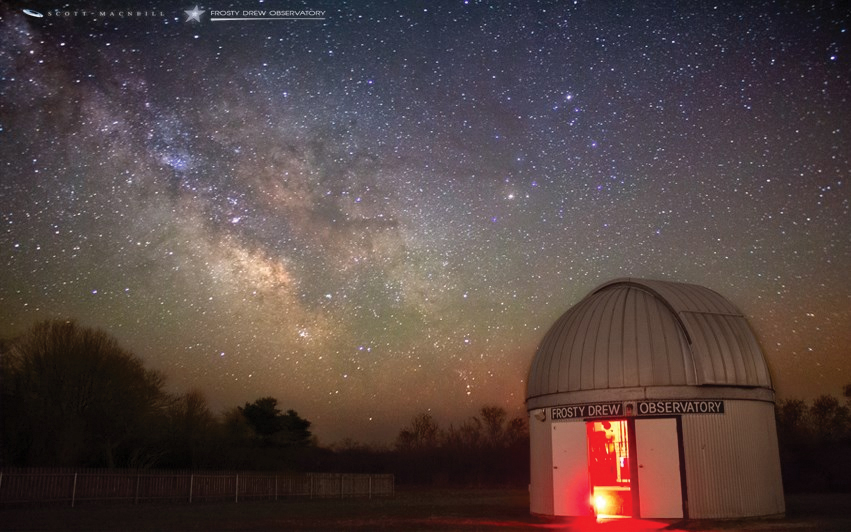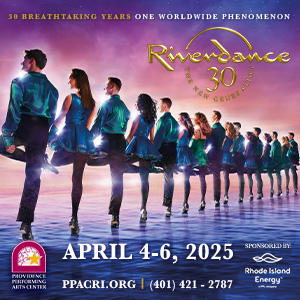My journey through the cosmos – by way of the Frosty Drew Observatory – began this past summer. I had attempted to go one Friday night in June. Unfortunately I neglected to notice the thick fog reminiscent of Stephen King’s The Mist during my hour long, 42-mile drive to Charlestown (Yes, I am a Rhode Islander so this was quite the excursion – snacks were packed and a playlist was made, including Space Oddity, Intergalactic, Across the Universe, Take Meta Mars, and more.). That fog may be the reason I have an insatiable urge to call it the “Frosty Dew Observatory.” But I digress.
Pro-tip for observatory novices like myself: A successful viewing is critically dependent on weather. Needless to say, this first stargazing voyage was futile. My drive was not completely in vain. There was some kind of an art installation on the surrounding grounds; dozens of blue and red paper lanterns were scattered about in the darkness and created a fantastical vibe where I imagined sprites might appear.
Frosty Drew also has a Sky Theatre located just a hop, skip and a jump away from the observatory dome. As I walked into the unassuming building, my ears pirked up a sound that instantly brought a sense of calm and familiarity. Sigur Rós was playing, whose music I would describe as universal music that could be the score to any moment in life no matter where it falls on the spectrum of significance. It seemed fitting for the spacey slideshow projected in the small, dimly lit, 20-seat room.
Gorgeous images of planets, star clusters, comets, meteor showers, eclipses, galaxies and our own moon in its various stages, among other astronomical images that are arguably NASA worthy, were projected. What’s incredible is that all of the photographs displayed in the Sky Theatre had been taken at the Frosty Drew with various cameras and imaging devices attached to their telescopes.
Fast forward to Friday, December 4, and my second attempted voyage to Frosty Drew was underway. It was a clear night and there was a break in the bizarre, early winter fog. Thank my lucky stars! The light pollution dissipated and the road grew darker as I traveled to Ninigret Park, a site recognized for its exceptionally dark skies.
Upon arrival, I noticed a few people standing outside of the Ash dome, where a red sciencey-wiencey glow was illuminating from inside through the open door, looking up at the sky and speaking to a man I would come to find out was the director of the Observatory, Scott MacNeill, who is usually found operating the primary telescope in the Observatory building. They were discussing a minor problem: The clouds overhead were interfering with visibility (clouds killing the cosmic vibes!). Luckily they passed within a half hour or so.
During this waiting time I headed into the Sky Theatre to keep warm (remember to dress warmly!) and was welcomed with the sounds of Sigur Rós once again. Inside, there were four pairs of other stargazers watching the photo display and quietly discussing each image with each other. People seemed to be paired off. I went stag to this event, but from what I detected, the observatory is a chill place to go on a date or visit with a group of friends. The stargazing goes on into the early morning hours or until viewers get sleepy and go home, whichever comes first.
Once the sky cleared, people meandered over to the observatory where the telescope is housed and the celestial magic happens. It was an intimate gathering. About 15 people total were taking turns looking through the telescope as MacNeill, astronomer extraordinaire, located and explained the evening’s cosmic sights – binary stars, star clusters and nebulae. The atmosphere inside of the observatory was devoid of any ego or pretentiousness: It was more like a science classroom where questions were welcome and thoughtful, educational answers were given. The only questions that Frosty Drew states they will not respond to include inquiries about astrology, horoscopes, palmistry, the Christmas Star myth or Nibiru – so if any of that flies your spaceship, then you’ll have to turn to Google or your favorite local mystic (see page 30).
Beyond the educational and fun aspect of looking at the universe through a high-powered lens was that inevitable existential facet to the experience. While being shown one nebula (essentially a dying solar system) about 33,000 light years away, MacNeill informed us that this is similar to what our solar system will look like sometime in the future. It’s rather heavy stuff that makes you realize we’re all just tiny beans in the grand scheme – specks of stardust.
Stepping outside the observatory and looking up at the cloudless night sky, I saw an unmistakably defined band of tightly compacted stars. This, we were told, was the Milky Way, our galaxy. We were looking at our place in the stars from the inside out, like being in the belly of a monster. This was comforting in an odd way, feeling a sense of place in the universe. Staring at the sky can be an emotional rollercoaster, for me at least.
Since Star Wars: The Force Awakens opens soon, I couldn’t resist asking if there was anything Star Wars themed or related planned for that night of stargazing (Star Wars was not on the list of question no-no’s). Perhaps a change in the music, or presentational cosplay? The answer I received was a polite, and slightly puzzled “no,” but rest assured, I was informed that the astronomers do geek out over Star Wars and often throw The Clone Wars on during downtime.
The Frosty Drew Observatory is open to the public every Friday for stargazing, weather dependent for obvious reasons that I now know. They are also open for certain celestial events, like the Quadrantids Meteor shower, which will peak on January 3 – 4. Frosty Drew has not yet announced an event for the Quadrantids, but stay updated at frostydrew.org if you’re into all this wibbly-wobbly, timey-wimey, spacey-wacey stuff. Frosty Drew is a non-profit, and free to attend (donations are welcome).
Frosty Drew Observatory & Sky Theatre, 61 Park Ln, Charlestown. frostydrew.org. Frosty Drew houses a fully automated, high-powered telescope surrounded by a viewing platform. Connected online to the observatory, astronomers can project observed images onto the overhead screen. 6 – 11pm, Fridays
Seagrave Memorial Observatory, 47 Peep Toad Rd, North Scituate. theskyscrapers.org. With four telescopes in operation, Seagrave Memorial Observatory is open to the public on clear Saturday nights, but they also host star parties and similar events for schools and scout groups. 7 – 9pm, Saturdays
Margaret M. Jacoby Observatory, CCRI Knight Campus, 400 East Ave, Warwick. ccri.edu/physics/observatory. Owned and operated by the physics department of CCRI, this 16″ Meade LX200R Reflecting Telescope hosts weekly public open houses when the skies are clear. 5 – 9pm, Wednesdays
Ladd Observatory, 210 Doyle Avenue, PVD. The historic Ladd Observatory opened in 1891 under the direction of Prof. Winslow Upton, and has since been owned and operated by the Brown University physics department. Its second director, famously known for his observations of solar eclipses, was Prof. Charles Smiley. 7 – 9pm, Tuesdays
Museum of Natural History & Planetarium, Roger Williams Park, 1000 Elmwood Ave, PVD. The Cormack Planetarium has undergone a series of renovations over the years, most recently the addition of a full dome projection system. The planetarium offers as many as 11 different shows on weekend afternoons, with special shows during school vacation weeks. 2pm, Saturdays & Sundays


